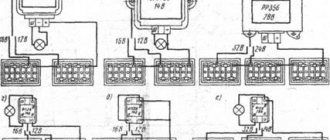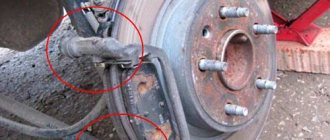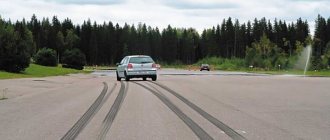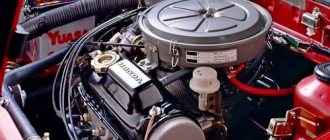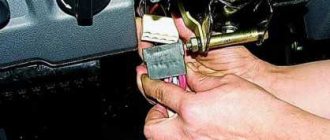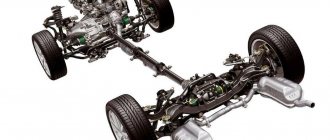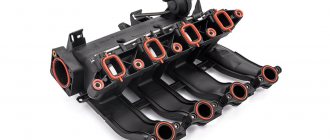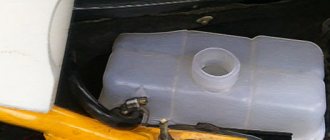Diagnostics from the cabin
The first stage of the inspection is carried out without leaving the car. To do this, press the brake pedal with the engine off. The pedal should stop almost immediately and should not move when further attempts are made to press forward. In this case, the impression of jamming should not be created.
If the pedal “sticks” at the slightest pressure, this means that it either has too short a stroke (that is, it does not have the ability to return all the way back), or the compensation hole in the master brake cylinder is blocked.
If the pedal has a large free play, then you need to actively press it several times, and if it stops pressing and becomes elastic, it means that there are air bubbles in the system. In this case, you need to look for the leak, repair the system and bleed the brakes.
To check the condition of the vacuum brake booster, press the brake pedal several times and, leaving your foot on the pedal, start the engine. If the brake booster is working properly, the brake pedal should “fall” some distance. If this does not happen, but instead a hissing is heard in the cabin, then the vacuum booster must be replaced.
Next, you should check the operation of the handbrake by lifting its lever up, while counting the number of clicks. When the handbrake is correctly adjusted, the handle rises 3-4 clicks. If the handle rises too high, you need to adjust the handbrake cable. At the same time, you should pay attention to the warning lamp on the instrument panel lighting up when you lift the handbrake handle.
Then, leaving the brake handle in the raised position, you need to put the gear in neutral, get out of the car and try to advance the car. If the car remains stationary and the cable is adjusted, the handbrake pads need to be replaced.
At this point, the inspection of the brake system elements from the interior is completed, and you can open the hood lock and proceed to the external inspection.
Brake system diagnostics
The brake system is one of the most important in a car, since the safety of the driver and passengers directly depends on its serviceability and flawless operation. Regular inspection, checking the degree of wear of its main components and their timely replacement guarantee normal vehicle behavior in the most emergency and unforeseen situations on the road. The "VVP" car service offers car owners to undergo a quick, high-tech and reliable check of the condition of the brake system of a car of any brand on a specialized test bench.
Verification steps
To inspect the condition of the brakes on the stand, it is enough for the car to drive onto special rollers, first with one pair of wheels and then with the other. After which the car is raised to improve visibility. The main diagnostic stages include:
— determination, using the most precise instruments and bench sensors, of the main parameters of the system’s operation;
— diagnostics of the presence of faults in the caliper area, the technical condition of the wheel bearing, brake discs and drums, as well as the functioning of the brake cylinder;
— visual inspection of pads and hoses, as well as containers with fluids for the brake system.
It is necessary to urgently check the brake system if: - the braking distance has increased; — the brake pedal is pressed too easily or completely falls to the floor; — brake fluid is leaking; — the brakes stick or operate spontaneously on some discs; — uncharacteristic sounds appeared.
Advantages of diagnostics in "GDP"
Our company's team of professionals will perform on-the-job diagnostics of your car's brake system in a high-quality and inexpensive manner in just half an hour. This type of check allows you to identify even hidden breakdowns and correct them before more serious faults appear.
High-quality prevention from “Autoservice” is guaranteed, since our specialists: - work using modern equipment; - understand the design features of cars of different brands; — have the necessary knowledge to competently analyze the data obtained; — have sufficient skills to accurately determine a possible breakdown.
Together with "GDP" the road is safer, and the most complex problems are solved more easily and simply.
Car repairs and maintenance are carried out by appointment.
Specialists of the VVP Auto Service Center will agree with you on the most convenient time for a visit by phone:
8-800-511-60-24 We invite you to make a replacement at our Automotive Technical Center, located at Borovskoye Highway, 28th kilometer, property 2A, building 1 . Near Rasskazovka metro station.
Inspection of elements located in the engine compartment
Having raised the hood, you need to check the presence and level of brake fluid in the expansion tank of the brake system. The liquid must be clean and filled to the upper level.
If the reservoir is located separately from the master brake cylinder and is connected to it with a hose (or hoses, if the reservoir has two compartments), then you need to make sure that the hoses do not leak and do not show signs of damage. If the brake fluid reservoir is located on the body of the brake master cylinder, you should inspect the rubber seals at the connection point.
Before continuing further inspection of the brake system, you need to unscrew the cap of the brake fluid reservoir and lower the float located on it, which will simulate a drop in the fluid level. To carry out further actions, you will need an assistant - he will look at the instrument panel, on which a light should light up, indicating that the brake fluid level is insufficient. If the light bulb does not respond to lowering the float, then you can connect the wires connected to the connector on the tank lid and the light should light up.
If the lamp does not light in this case, you should go to a service center so that specialists can find the break in the wiring or replace the lamp.
If the lamp works, you can continue the diagnosis and inspect the brake master cylinder at the point where the brake pipes are connected. The cylinder body and tubes must be dry.
Next, you need to inspect the housing of the vacuum brake booster; it should also be dry and free of rust. At the same time, check the vacuum hose and its connection to the intake manifold fitting.
What kind of service is this?
A brake system malfunction can ruin any plans.
To each. That’s why you need to monitor it regularly, and especially before a long journey. Inattention to it promises considerable problems. Moreover, the risk lies not only in the sudden movement of a car with the parking brake on, but also in the inability to stop the car in time in a critical situation. Comprehensive diagnostics using 50 parameters will help identify all problems. Is there a noise? Intrusive squeaks? Has braking efficiency decreased? Is your brake pedal too soft or too hard? Don’t delay contacting the mobile service. Our specialists are waiting for your call. Diagnostics of the brake system will be carried out as soon as possible.
What does the brake system consist of?
The list of parts for this unit includes:
- Main and working cylinders;
- Brake booster;
- Brake discs, drums (if any), pads;
- Brake hoses;
- Calipers;
- Brake fluid;
- ABS sensors.
The service life of the brakes depends both on the quality of the parts used and on the mode in which they are operated. Thus, cars that spend most of their time outside the city brake system malfunctions 20-30% less often than those in cars. However, regardless of driving style, it is not recommended to exceed the manufacturer’s requirements for service regulations. For example, brake pads require replacement on average at 40-45 thousand kilometers, discs last for 100-120 thousand, brake hoses last about 5-7 years. Brake fluid must also be regularly replaced every 2 years (the presence of moisture more than 3.5% is unacceptable). The remaining elements are changed in accordance with the actual condition: either based on complaints from the driver, or when other operations are carried out by a specialist (replacing or adjusting brake pads, discs, etc.).
Despite the large number of seemingly simple works, it is strongly recommended that they be carried out exclusively by qualified craftsmen who are able to correctly assess the actual condition of the system.
Replacing brake fluid
Why is it important to change brake fluid?
Over time, brake fluid becomes contaminated due to extreme pressure, heat and moisture. If you do not change the fluid, this can lead to a deterioration in the braking performance of your car. Dirty brake fluid can also damage the hydraulic components of the brake system. Changing the fluid is a preventative maintenance procedure that restores the functionality of the brake system. In addition, this procedure makes it possible to prevent damage to the system and extend the service life of its elements.
What is included in the cost of the service?
- Road testing to evaluate the effectiveness of the braking system.
- Flushing the brake system, removing old brake fluid.
- Filling with new brake fluid up to 1 liter.
- Full brake system inspection, written assessment
- Comprehensive assessment of the brake system based on the manufacturer’s requirements and the opinion of our specialist.
- Compiling a detailed list of system elements that require additional configuration, repair or replacement.
Features of the procedure
Diagnosis of the brake system, the price of which is affordable, is carried out using the road and bench methods. The first is based on assessing the performance of the car while driving; such a study can be carried out by the driver himself if he has extensive experience in driving and knowledge of the operating features of the vehicle. The car service offers a more reliable and complete assessment, which is carried out using various test benches:
- static;
- roller;
- inertial;
- on-site.
Comprehensive brake system diagnostics provide a complete picture of the condition of the brakes. Thus, our specialists identify any problems, even at the initial stages.
Accurate diagnostics of car brakes in Moscow
A procedure such as brake diagnostics allows you to detect and eliminate brake faults at an early stage. Thanks to this, the cost of this operation is significantly less than the cost of a full repair. In addition, information about the remaining life of parts will allow you to replace some of them in time. Car service specialists can determine the optimal setting of this system. Many faults that cannot be detected on your own are often discovered during this procedure. This makes it a great way to troubleshoot problems before they cause serious damage that requires costly repairs.
Autoservice-24 uses high-quality equipment that allows you to obtain the most accurate information about the condition of certain vehicle systems. In addition, our employees have extensive experience working with machines of various brands and models. Thanks to this, we offer our services to a wide range of clients.
If there is a need for brake diagnostics, and you don’t have enough free time, you should contact our technical center. Here, your car's brakes will be checked not only efficiently, but also very quickly.


